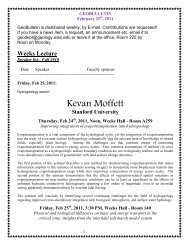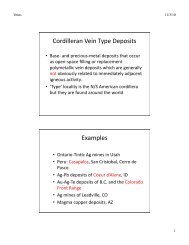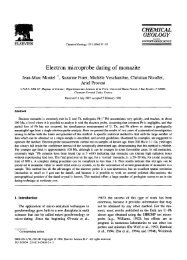Fe-Zn-S system and the sphalerite geobarometer
Fe-Zn-S system and the sphalerite geobarometer
Fe-Zn-S system and the sphalerite geobarometer
You also want an ePaper? Increase the reach of your titles
YUMPU automatically turns print PDFs into web optimized ePapers that Google loves.
<strong>Fe</strong>-As-S <strong>system</strong> <strong>and</strong> <strong>the</strong> arsenopyrite<br />
geo<strong>the</strong>rmometer!<br />
� Barton <strong>and</strong> Skinner (1979) <strong>and</strong> Vaughan<br />
<strong>and</strong> Craig (1978) have prepared extensive<br />
lists of reaction points that serve as<br />
potentially useful fixed point<br />
geo<strong>the</strong>rmometers. Fig. 4 shows <strong>the</strong><br />
invariant points of S-Sb, S-Se, <strong>and</strong> S-Sn<br />
<strong>system</strong>s that are of possible interest to <strong>the</strong><br />
geo<strong>the</strong>rmometry of an ore deposit.<br />
� Fixed point geo<strong>the</strong>rmometers are minerals or<br />
mineral assemblages that undergo a reaction<br />
(e.g. melting, inversion, reaction to form a<br />
different assemblage) at a defined temperature.<br />
For example, crystals of stibnite must have<br />
formed below its melting point (556°C) <strong>and</strong> <strong>the</strong><br />
mineral pair pyrite+arsenopyrite must have<br />
formed below 491°C. The fixed points thus do not<br />
sharply define <strong>the</strong> temperature of equilibrium but<br />
ra<strong>the</strong>r set upper <strong>and</strong> lower limits.<br />
8





